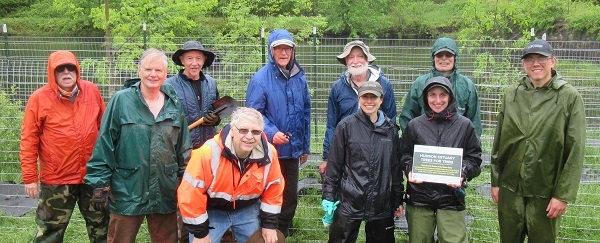Hudson RiverNet: Thankful for our Volunteers and Partners
The New York State Department of Environmental Conservation sent this bulletin on 11/20/2018 10:30 AM EST |
| DEC Delivers - Information to keep you connected and informed from the NYS Department of Environmental Conservation |
| Share or view as a web page || Update preferences or unsubscribe |
|
|
Volunteers and partners are vital to the collaborative work of protecting and restoring the Hudson and its watershed. Whether counting eels, planting trees along stream banks, assisting breeding amphibians across roads, or recording details about striped bass fishing trips, volunteers increase our understanding of New York’s wildlife and natural resources. We couldn't do it without you. Thank you! Hudson River Estuary Trees for Tribs
Amphibian Migrations and Road Crossings
of migrations in the Hudson Valley.
Hudson River Cooperative Angler Program
New York State is required by the Atlantic States Marine Fisheries Commission, an interstate cooperative fishery management agency, to provide information from our recreational fishery in order to keep our fishery open. Since 2000, we satisfy this requirement and learn more about the recreational fishery with the help of volunteer recreational anglers. Hudson River Cooperative Anglers share their striped bass fishing trip information to help biologists understand and manage the Hudson’s striped bass fishery. Whether they catch-and-release or take home a keeper, anglers fill out a logbook to record general location, time, gear used, and what was caught, returning the logbook when they are done fishing for the season. From March through May, hundreds of trained volunteers from environmental groups and local schools check twelve-foot “fyke” nets to catch, count, and release tiny “glass eels”— juvenile American eels-- on their migration from ocean to estuary to stream. The project provides crucial information on the strength and timing of this migration, and connects a wide diversity of people to their environment. The eel project is coordinated by the NYSDEC Hudson River Estuary Program and the Hudson River National Estuarine Research Reserve, in partnership with the Water Resources Institute at Cornell University. Teams of scientists, students, and community members collect glass eels using specialized nets and traps on Hudson River tributaries each spring. The juvenile fish are counted, weighed, and released, and other environmental data is recorded. At the end of each season the data is compiled and sent along to decision-makers.
|

 Hudson RiverNet
Hudson RiverNet Watershed groups, conservation commissions, scouts, and many other people help plant native trees, grasses and shrubs along tributary streams to reduce erosion and flood damage. This spring, the Quassaick Creek Watershed Alliance and the Town of Newburgh partnered with Hudson Estuary Trees for Tribs staff to plant town land along the Quassiack Creek that drains to the drinking water reservoir for the town. On-the-ground community actions like these help protect source water. The banner photo shows this group of hard-working volunteers who planted all morning despite the rain!
Watershed groups, conservation commissions, scouts, and many other people help plant native trees, grasses and shrubs along tributary streams to reduce erosion and flood damage. This spring, the Quassaick Creek Watershed Alliance and the Town of Newburgh partnered with Hudson Estuary Trees for Tribs staff to plant town land along the Quassiack Creek that drains to the drinking water reservoir for the town. On-the-ground community actions like these help protect source water. The banner photo shows this group of hard-working volunteers who planted all morning despite the rain!

